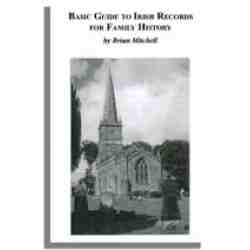Irish genealogist and geographer Brian Mitchell is the author of numerous textbooks on Irish genealogy, including several how-to books, collections of ships’ passenger records, and guides to Irish parish and cemetery records. This offering by Mr. Mitchell was inspired by the growing number of Irish sources available on the Internet. It provides an up-to-date overview of the key sources for Irish research. Considering that more than 70 million persons emigrated from Ireland over a 300-year period, researchers should welcome Brian Mitchell’s latest contribution to our understanding of this subject.
According to the author, Irish genealogical records fall into the following eight major categories: (1) civil registers of births, marriages, and deaths, (2) church registers of baptisms, marriages, and burials, (3) gravestone inscriptions, (4) wills, (5) 1901 and 1911 census returns, (6) mid-19th-century Griffith’s Valuation, (7) early 19th-century Tithe Applotment Books, and (8) other census substitutes. Mr. Mitchell examines each of these sources in detail, explaining what information they contain (often with facsimile reproductions of sample documents), where the originals/copies can be found, how to use them, and whether or not they can be accessed remotely via the Internet. His discussion of these basic sources for Irish research comprises about two-thirds of the book.
Brian Mitchell’s knowledge of the role of geography in Irish genealogy is second to none. This perspective informs the arrangement of the balance of the volume. Anyone who conducts research pertaining to Ireland needs to know that the country is divided into seven overlapping administrative divisions: four provinces, 32 counties, 327 baronies, 2,428 civil parishes, more than 60,000 townlands, 130 Poor Law Unions (which are themselves divided into Registration Districts and District Electoral Divisions), and 12 probate districts. The author explains the genealogical function of each division.
Next comes all the contact information for the five major genealogical record offices in Ireland: the General Register office at Joyce House, Dublin; the General Register Office at Oxford House, Belfast; the National Archives of Ireland and the National Library of Ireland, Dublin; and the Public Record Office of Northern Ireland, Belfast. Mr. Mitchell, who has managed an Irish Genealogy Centre (where local residents can conduct genealogical research at little or no charge) for many years, includes a current, comprehensive list of all the centres throughout the country, complete with phone number, Web address, and e-mail for each.
The final section contains a list of the Internet sites devoted exclusively or substantially to Irish genealogical research, followed by a core bibliography of the best sources now available.


